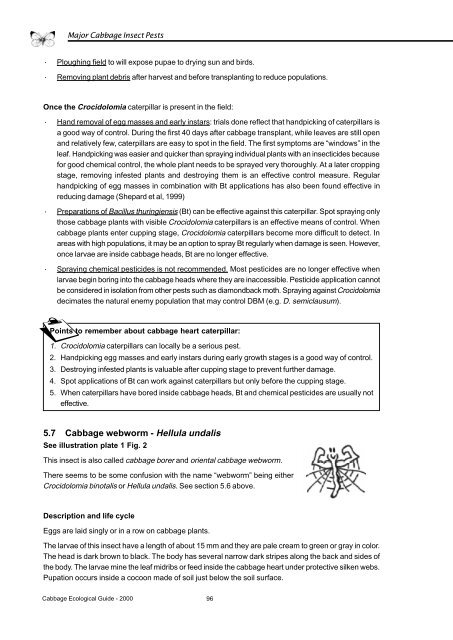Cabbage Integrated Pest Management : An Ecological Guide.
Cabbage Integrated Pest Management : An Ecological Guide.
Cabbage Integrated Pest Management : An Ecological Guide.
Create successful ePaper yourself
Turn your PDF publications into a flip-book with our unique Google optimized e-Paper software.
Major <strong>Cabbage</strong> Insect <strong>Pest</strong>s· Ploughing field to will expose pupae to drying sun and birds.· Removing plant debris after harvest and before transplanting to reduce populations.Once the Crocidolomia caterpillar is present in the field:· Hand removal of egg masses and early instars: trials done reflect that handpicking of caterpillars isa good way of control. During the first 40 days after cabbage transplant, while leaves are still openand relatively few, caterpillars are easy to spot in the field. The first symptoms are “windows” in theleaf. Handpicking was easier and quicker than spraying individual plants with an insecticides becausefor good chemical control, the whole plant needs to be sprayed very thoroughly. At a later croppingstage, removing infested plants and destroying them is an effective control measure. Regularhandpicking of egg masses in combination with Bt applications has also been found effective inreducing damage (Shepard et al, 1999)· Preparations of Bacillus thuringiensis (Bt) can be effective against this caterpillar. Spot spraying onlythose cabbage plants with visible Crocidolomia caterpillars is an effective means of control. Whencabbage plants enter cupping stage, Crocidolomia caterpillars become more difficult to detect. Inareas with high populations, it may be an option to spray Bt regularly when damage is seen. However,once larvae are inside cabbage heads, Bt are no longer effective.· Spraying chemical pesticides is not recommended. Most pesticides are no longer effective whenlarvae begin boring into the cabbage heads where they are inaccessible. <strong>Pest</strong>icide application cannotbe considered in isolation from other pests such as diamondback moth. Spraying against Crocidolomiadecimates the natural enemy population that may control DBM (e.g. D. semiclausum).¤Points to remember about cabbage heart caterpillar:1. Crocidolomia caterpillars can locally be a serious pest.2. Handpicking egg masses and early instars during early growth stages is a good way of control.3. Destroying infested plants is valuable after cupping stage to prevent further damage.4. Spot applications of Bt can work against caterpillars but only before the cupping stage.5. When caterpillars have bored inside cabbage heads, Bt and chemical pesticides are usually noteffective.5.7 <strong>Cabbage</strong> webworm - Hellula undalisSee illustration plate 1 Fig. 2This insect is also called cabbage borer and oriental cabbage webworm.There seems to be some confusion with the name “webworm” being eitherCrocidolomia binotalis or Hellula undalis. See section 5.6 above.Description and life cycleEggs are laid singly or in a row on cabbage plants.The larvae of this insect have a length of about 15 mm and they are pale cream to green or gray in color.The head is dark brown to black. The body has several narrow dark stripes along the back and sides ofthe body. The larvae mine the leaf midribs or feed inside the cabbage heart under protective silken webs.Pupation occurs inside a cocoon made of soil just below the soil surface.<strong>Cabbage</strong> <strong>Ecological</strong> <strong>Guide</strong> - 200096




![Section 4 [ PDF file, 252 KB] - The Field Alliance](https://img.yumpu.com/51387260/1/158x260/section-4-pdf-file-252-kb-the-field-alliance.jpg?quality=85)











